As a nature connection organization, we know plants.
We use them for food, medicine, fibre, shelter, fire, and dyes, and teach others how to do the same. Basically, we think plants are awesome.
So we’d love to introduce you to a few of our favourite wild edible and medicinal plants. Not only are these plants abundant – many can be found on lawns and in gardens everywhere – but they are also often seen as “weeds”.
We hope this provides inspiration to learn more about, and even fall in love with, these commonly overlooked plants. We strongly encourage you to attend some workshops and training before diving in – suggestions provided at the end.
And remember, a “weed” is just a plant in the wrong place. But if it’s useful, is it really in the wrong place? Hmm…
Plantain
Plantago sp.
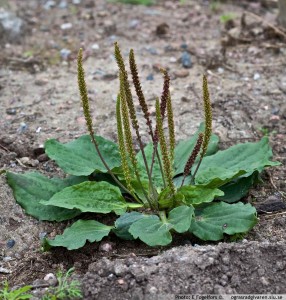
No, not the fruit that looks like a banana… I’m talking about the plant that grows in every lawn, the plant that you’ve probably seen a thousand times and never thought anything of. Leaves arranged in a rosette, veins that run to the tip of the leaf, little strings inside of the veins, and flower/seed stalks that grow tall and whip your feet when you run – yeah, that plant.
As an astringent, anti-bacterial, and anti-inflammatory, plantain helps to heal bites, burns, stings, cuts, and scrapes. A poultice can be made with the leaves, or, if you don’t have an aversion to your own saliva, you can make a “spit salve” – chew the leaves up into a paste and put it on the affected area. It’s really good for stubborn slivers if you leave a poultice on them overnight.
Plantain is also high in vitamins A, C, and K, and the seed husks contain tonnes of fibre and can be used in the same way as psyllium husk. The young leaves can also be used in soups, salads, or whatever recipe calls for some greens!
Dandelion
Taraxacum officinale
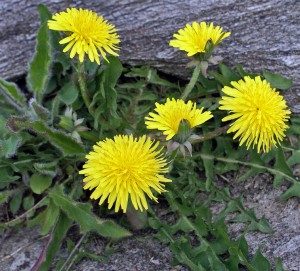
You know those pretty yellow flowers that people keep tirelessly pulling out of lawns? They are probably one of the most versatile, helpful flowers out there. Dandelions are one of the first sources of food for pollinators and they are highly medicinal and nutritional.
Dandelion root contains a bitter substance called taraxacin which stimulates digestion by promoting the flow of bile from the liver and gallbladder, as well as hydrochloric acid in the stomach. Any time you have increased digestion, the absorption of nutrients and the removal of wastes from the body improves. It also has a coffee and caramel-like flavour, making the roasted root a great coffee substitute.
Dandelion greens also have more nutrients than spinach, containing vitamins A, C, K and B2. The milky white sap of the dandelion present in the stem can also be applied to warts on a daily basis to get rid of them. Dandelion flowers can be made into syrup, jelly and wine or even battered and fried up as a fritter.
Garlic Mustard
Alliaria petiolata
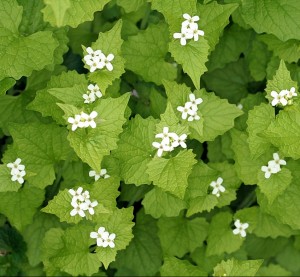
Garlic Mustard is a biennial plant in the Mustard family that is abundant. This plant is invasive and can out-compete native species. Can’t beat the invasives? Eat them!
All plants in the mustard family are edible and Garlic Mustard, which is high in vitamins A and C, has an especially spicy-garlicky-mustardy and pungent (yet delicious) flavour to it. Every part of the plant is edible, too: the roots, stems, leaves, flowers, and seeds. The roots of the first year plant can be used to make a horseradish-style condiment. The stems, leaves and flowers can be made into pesto, pickled or fermented. And the seeds can be made into mustard and are a great topping for salads and soups.
Special Note: Garlic Mustard seeds can stay dormant in the soil for 6-10 years and only sprout once disturbed. The best way to harvest the plant is to cut it with scissors at the base. Pulling up the root causes further disturbance of the soil, triggering new growth.
Stinging Nettle
Urtica dioica
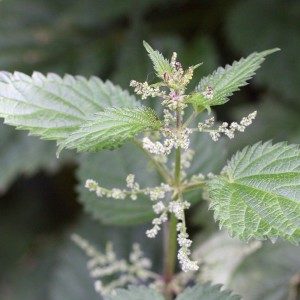
Don’t let the word “stinging” fool you into thinking that this plant is some kind of criminal. We all use different methods to protect ourselves and this plant has simply discovered a successful (yet painful) way of doing so. Underneath the leaves and on the stems of Stinging Nettle plants are sharp hairs that contain formic acid, histamine and acetylcholine, which causes painful (but tolerable) and itchy hives when skin comes into contact with them. However uncomfortable the sting may be, the plant is edible (yes, no joke!), highly medicinal, and has been used this way for hundreds of years.
Nettle is one of our most nutritious wild foods, chock-full of vitamins and minerals such as vitamins A, B complex, K, & D, iron, potassium, silica, and calcium. Nettle can be used like kale or spinach – crushing, blanching or sauteing the leaves will deactivate the stinging hairs, making it easier to consume.
The roots, leaves and flowers, when made into a tea or tincture, can help alleviate allergic reactions, improve blood flow, quell inflammation, alleviate joint pain, help to strengthen the kidneys and eliminate kidney stones, and do a whole host of other beneficial things for the human body.
Jewelweed
Impatiens capensis/pallida
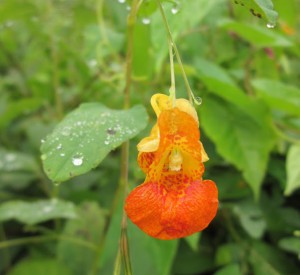
At the Pine Project, we have a song that goes:
“Jewelweed, jewelweed, we love you! You help us with the poison ivy and you’re pretty, too!” And we definitely do love Jewelweed. Named after the way water droplets shimmer like little jewels on the leaves, not only is Jewelweed a beautiful plant, but it’s a fantastic defence against poison ivy.
If you’re fortunate enough to realize that you’ve come into contact with poison ivy, breaking up the stems and leaves of the entire jewelweed plant and rubbing the affected area with the plant juices can prevent a rash from forming. If you end up with a rash, jewelweed can help to heal and soothe the affected area. Used in combination with soap, the results have proven to be hugely successful.
The plant is not only medicinal, it is mesmerizing. The leaves have a water-repellent coating that help form the jewel-like drops I mentioned before – and if you submerge the entire plant in water, it appears silver. The magic doesn’t stop there. The mature seed pods of this plant are spring-loaded, which means they explode on contact. That’s why the plant’s other common name is “Touch-Me-Not”.
We’ve shared this list of our favourite edible and medicinal “weeds” as inspiration to learn more. We strongly encourage training and workshops with an experienced provider before diving in. Check out Earth Tracks, Wild Foragers Society, and Edible Wild Food. Also subscribe to our newsletter, follow us on Instagram, and “like” us on Facebook to hear about our upcoming courses and skills nights.
*Disclaimer
We strongly recommend attending training and workshops with a qualified provider before consuming any wild plants. We stress that you do not eat any wild plants until you are 100% sure of their identification, having used multiple reliable sources to make your identification. There are plants out there that can seriously harm you or even kill you if you consume them. Some plants can have adverse effects on certain people, especially those with preexisting medical conditions or allergies. The Pine Project cannot be held responsible for any allergy, illness or injurious effect that any person or animal may suffer as a result of using any of the plants mentioned in this article.
If you’re using plants as food or medicine, it’s imperative to always harvest ethically, legally, and responsibly. Let’s all do our part to make sure future generations can enjoy the same plants in an even greater abundance.